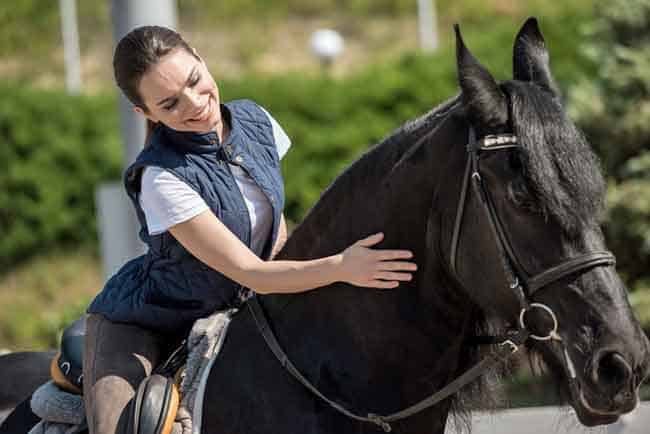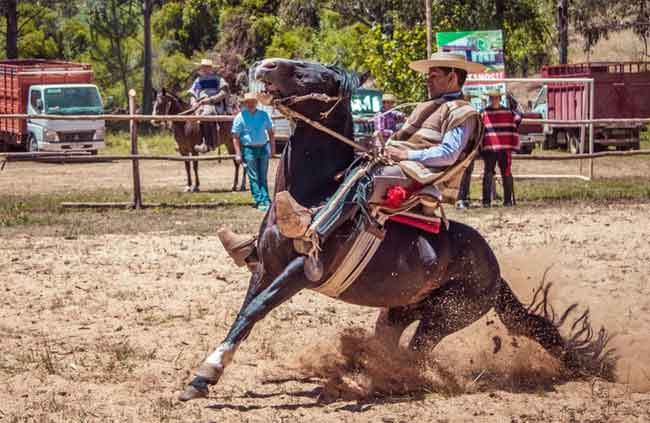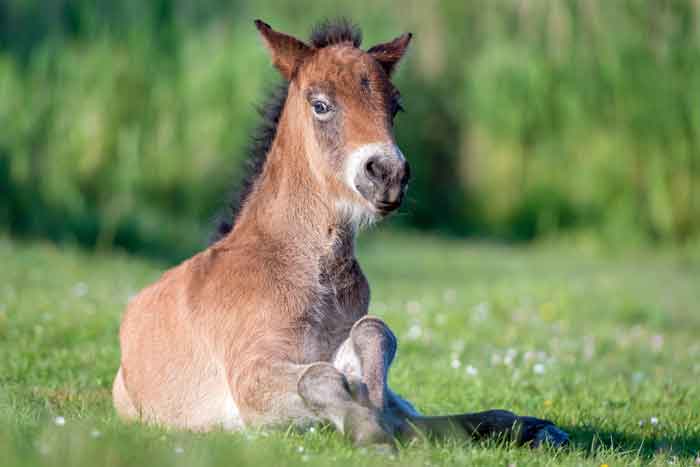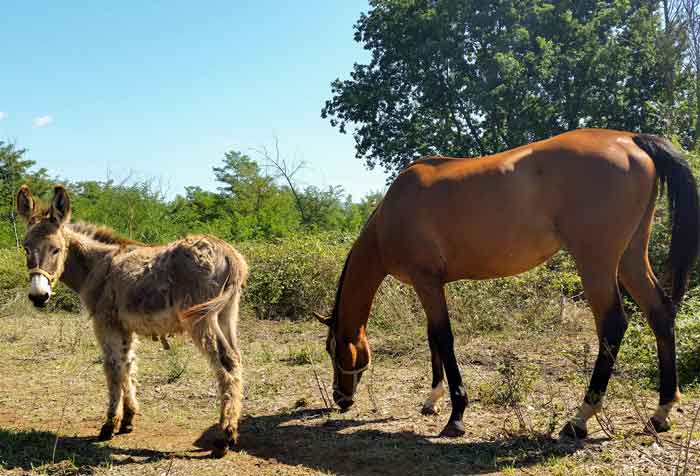Do you want to teach your horse how to stop?
Here are the five best exercises for teaching a horse to stop.
Table of Contents
Stopping is probably the most important thing for the horse to learn. You need to train your horse to do this well and here are some exercises you can use.
Great Stopping Exercises For Horses

When we are working with a green horse we need to start with easy exercises.
Be aware, that a foal will not be able to stand still for very long. They have very short attention spans just like toddlers and you cannot expect them to pay attention for too long at a time. You need patience here and you need to take small steps every day and repeat everything over and over again.
1) Teaching The Whoa Stop
The “whoa” is the first command you should teach a horse. It’s the most important command as we need to be in full control of the horse at all times.
Here’s exactly what we want to accomplish. We want the horse to do a complete stop when we say the word “Whoa” and we want it to do nothing until we give it the next command.
1) Ride along a fence
Take your horse for a walk or a slow trot. A good tip at this point is to ride along the fence. This will let you focus on teaching the stop command and not pay too much attention to steering.
Riding along the fence also gives you another advantage.
It will allow you to slightly pull the horse toward the fence if it refuses to stop. By doing so, the horse has to stop because he cannot turn directly into the fence.
When you want to stop him you should sit up as let yourself “feel heavy” into the saddle.
2) Pull the reins gently
Now you pull the reigns a little bit to let him know that we want him to stop.
Say “Whoa” every time you want him to stop in order to help him learn this aid. The first many times you pull the reign a little bit and release, basically to catch the attention of him.
The first couple of times you might need to pull the reins in order to turn him toward the fence. This will let him know that you mean business. He will not want to walk into the fence and when you prompt him to do so he should stop after a little while.
The first couple of times he actually stops you should praise him and tell him how good a boy he is. After a while, you shouldn’t praise him if you have to pull him toward the fence in order to make him stop.
We only force him toward the fence to let him know what we are trying to accomplish. As soon as he gets it, you should use the reins together instead, so he is not prompted to make a turn. He will probably pick this up soon. If you are sensing that he knows actually what you want to accomplish, but still refuses, you should go on to the next step.
3) Pull and release if you have to
If this doesn’t get the horse to stop you can do multiple sets of easy “set-and-release” movements with the reins.
This means that you tighten the tension on the reins and loosen that tension back up. You will let the horse know that you want it to stop.
This should get the horse to stop.
You need to sit down straight in the saddle so the horse doesn’t just pull you forward out of the saddle if he’s not set on stopping. You should let it pull you deeper in the saddle instead of pulling you forward. This position may take some work and it’s important that you get it right.
The horse shouldn’t be able to pull you forward in the saddle. It needs to feel that you are a rock-solid foundation that is in full control at all times.
4) Punish a slow stop
If your horse is doing a very slow stop and you want it to respond faster you should back it up a little bit after you stop.
You do this by adding a little tension to the reins in order to make it step backward a couple of steps. This will let the horse know that you are in control and it can work as a light punishment.
The reason why this can function as a tiny punishment is that the horse just showed you that he wants to continue walking. So instead, we let him step a few steps backward which are the opposite of what he wants.
If the horse refuses to stop…
If you cannot get the horse to stop simply by telling it to do so or by adding a little pressure on the reins, here’s what you can do.
First, you should shift your balance forward to make it harder for the horse to move the front legs. By doing so you are reinforcing the command to the horse.
By moving your balance point forward on the horse you make it unnatural for the horse to keep going. It shouldn’t be able to move as easily and this will often cause the horse to stop immediately.
The horse should know by now that you mean business.
Secondly, you need to make sure you are applying an even force on the two ropes of the reins. If you are pulling one hand harder than the other you are basically telling the horse to turn around instead of stopping. This is important and you need to teach yourself how to do and even pull without pulling too hard on the reins.
Great Tips For Teaching A Horse To Stop
Here are a few other helpful tips on how to teach your horse to stop.
1) Short stretches
A good tip is to only walk short stretches between the many stops.
Whenever you try to teach the horse to stop you need to stop often. Horses like to walk and if you wait too long between the many stops it may want to ignore you.
By stopping and starting over and over again you reinforce what you want to teach and you also let it know exactly what’s going on.
Horses have their own personality and temper and for some horses, it will be best to walk them slowly and do many stops while other horses prefer to stand still. When you know the horse you can decide whether it motivates them with a longer stop or a longer walk.
2) Be (very) consistent
You need to be very consistent with horses.
If you teach the horse to stop within 5 steps you need to reinforce this rule every time. If, on the other hand, you teach the horse to stop within 3 steps, the need to reinforce this every time.
This means that you should let the horse know that it did wrong if it stops after 6 steps if you taught it to stop after 5 steps.
The stop command this one of the first things you will teach your horse so it’s very important that it also learns how consistent you want things to be. This will make it easier to work with the horse in the long run. It will quickly pick up that you are either consistent or not consistent.
If you are not consistent with your rules the horse will become lazy and you would have a harder time teaching in a lot of other things as well.
3) Ride him tired the first times
Another great tip for teaching your horse to stop is to make him tired before you start the training. By doing so, he will want to stop and that can sometimes make it easier to make him listen.
But pay attention to how the horse reacts.
Some horses will not do well when they are tired. It might get too tiring (mentally) and then it can be hard to teach the horse anything. This tip is meant for horses that have a ton of energy. By letting them burn off some energy before you start working on the stop, it might get easier.
4) Stop while accelerating
When the horse is gaining speed, the hindquarters will be lowered a bit compared to the front end and this can make it easier to stop.
Otherwise, the horse will sometimes bend too much forward, if you ask it to stop while it is already losing speed.
5) Keep a relaxed position
Many beginners will tighten up their whole body when they are about to get the horse to stop.
This can be because you get a little nervous or simply because you try to concentrate really hard. But it’s really a bad idea.
You need to sit relaxed in the seat in order for the horse to feel relaxed. The best thing you can do is to control your breathing and get into the stop at an exhale.
By doing so consciously you make sure the horse doesn’t feel any tension from you. It would help the horse to see that this is a very natural thing is not something to be afraid of. It also helps you to do your movements right in order to push your feet a little forward and sit back into the saddle.
You should let the force from the stop push you forward in the saddle without resisting it too much.
Teaching A Horse To Slide Stop

Now that your horse knows how to stop you can work on teaching it to stop with a slide. If you are going fast you need to know how to do a sliding stop.
The sliding stop is a special way for the horse to stop where it will lower its hind legs in order to do a quick stop.
First, you need to take it up to a pretty high speed. Let it canter and find a good rhythm and make sure you sit well in the saddle so you can apply the force toward the saddle when you are going for a fast stop as the sliding stop. You need to lean back a little bit and be absolutely sure you are not leaning forward too much at this point.
Now you will get ready to cue the horse by yelling “Whoa” and let it feel you pushing yourself down in the saddle. At the same time, you should let your legs swing forward to be ready for the stop.
Make sure to make these bodily changes quickly so the horse knows that something is going on that needs attention NOW.
Make sure not to pull back on the reins. The horse needs to stop by itself without you having to pull it out of him.
Make sure to practice this over and over again until the horse is very confident and can do this without any trouble. You both need to know exactly how to react during a sliding stop.
Don’t over-do it
You should also be aware that this is not too easy for the horse. Some horses will find it to a lot of fun but other horses will not like to do sliding stops.
You need to feel the horse and you shouldn’t push it forward if it doesn’t want to do it several times. It’s important to learn to do a sliding stop but it’s not something you want to do all the time.
It’s pretty hard for the horse to do it and you should keep practicing it without stressing the horse. Make sure it still knows how to do it and listen to how it reacts.
Remember To Praise The Horse
You should always remember to praise the horse whenever it does what you want. Say something like “good girl” or a “good boy” and make sure to pad it gently on the side.
This is very important because the horse is a very social creature and it will respond well to being praised.
Just like you and I, it likes being told whenever it is doing something properly. This is also an important thing to do continuously in order to build trust and a good and strong relationship between you and the young horse.
It will also let the horse know whenever it didn’t do what you wanted it to. Simply by avoiding to praise it whenever it was rebellious or didn’t stop when you wanted to do so.
There are different ways of rewarding it. You can do so by telling it how well it did it and give it a little pad on the side. You shouldn’t give it a treat every time it does something well because it will want to have a treat every time in the future. There’s no need for this. It’s enough to price it verbally.
You can also be rewarded by giving it a longer break if you feel like the horse likes to stand still. If your horse likes to run really fast you can also reward it by letting it canter for a while.
What Do You Say To A Horse To Make It Stop?
You yell “Whoa” in order to make a horse stop. You should sit deep in your saddle to make the horse feel that you want to slow down the rhythm. If this doesn’t work you can pull the reigns and even give the horse a little kick in the ribcage.
It’s really important to stick to this word because it’s universally applied.
Other riders might ride him at some point and they will use the same word when they need the horse to stop.






